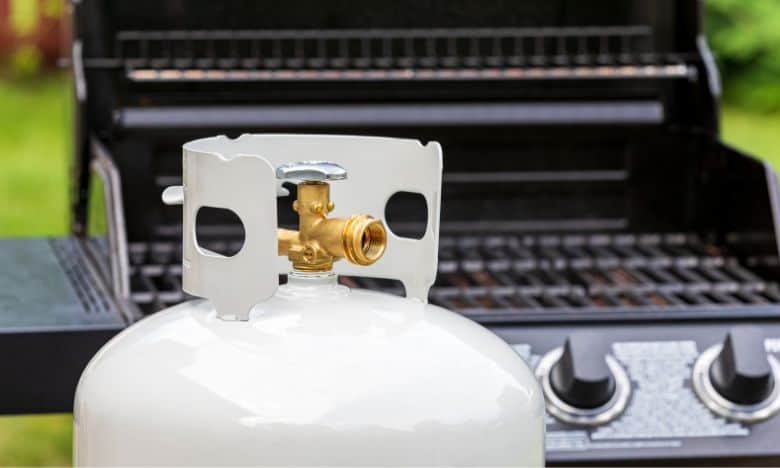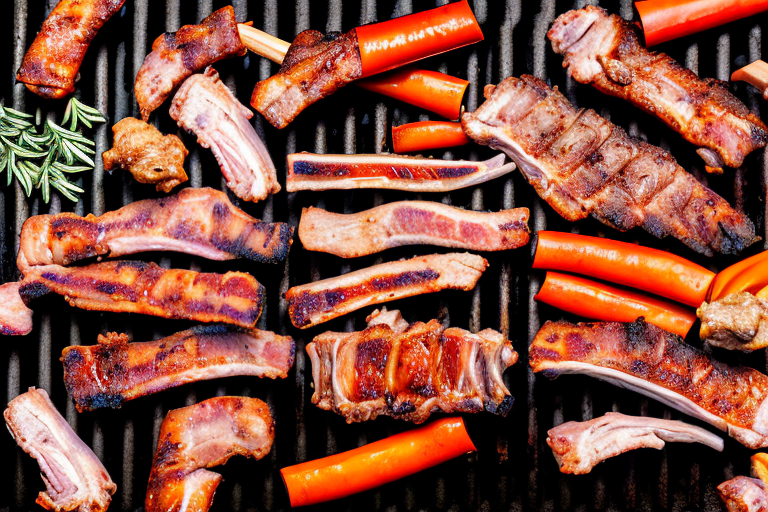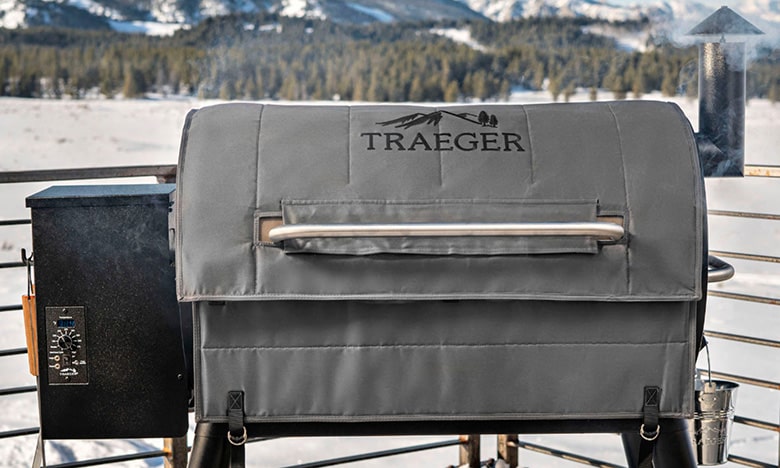If you want to wrap your brisket to keep it moist and flavorful during the cooking process, you have a few options to choose from. Three popular methods for wrapping brisket include aluminum foil, butcher paper, and the foil boat method.
In this post, we’ll take a closer look at each of these wrapping brisket methods, comparing the benefits and drawbacks of each one to help you decide which is best for your needs. So, whether you’re an experienced BBQ enthusiast or new to the grilling world, read on to learn more about the different methods of wrapping brisket.
Table of Contents
When to wrap Brisket
We recommend for wrapping brisket when it reaches an internal temperature between 165°F and 180°F (about 8-10 hours into the cook) and gets stuck in the “brisket stall”. Wrapping brisket during this time will help get it past the stall and continue cooking until it reaches it’s done internal temperature of 202°F.
The Brisket Stall Explained
The brisket stall is a phenomenon that occurs when you’re cooking a brisket. During the cooking process, the internal temperature of the brisket (the temperature inside the meat) will rise slowly. This is because the heat is being absorbed by the meat and cooking it from the inside out.
However, there is a point in the cooking process when the internal temperature of the brisket will suddenly stop rising for a while. This is called the brisket stall. It usually happens when the internal temperature of the brisket is between 165°F and 180°F. The stall can last for several hours, and it can be frustrating because it makes it hard to know how long it will take to cook the brisket.
The brisket stall happens because the heat and moisture inside the meat start to escape. This creates a barrier around the outside of the meat that makes it harder for the heat to get inside and cook the meat. The heat and moisture escape because the meat is hot and the moisture turns into steam, which rises up and out of the meat.
To get through the brisket stall, some people used to do wrapping brisket in foil or butcher paper. This creates a more moist and steamy environment inside the wrap, which can help to soften the exterior of the brisket and create a more tender texture. It can also help to speed up the cooking process by allowing the heat to penetrate the meat more quickly.
Wrapping Smoked Brisket
There are a few reasons why people wrapping brisket during the cooking process:
- To keep the meat moist and tender: Wrapping brisket can help to retain the natural juices and moisture from the meat as it cooks, which can help to prevent it from drying out.
- To create a flavorful bark: Wrapping brisket can also help create a flavorful bark, or crust, on the meat’s exterior. When the meat is wrapped, the steam and moisture from the foil or butcher paper can help soften the brisket’s exterior, making it easier for the rub or seasoning to penetrate the meat and create a flavorful crust.
- To make it easier to transport the brisket: Wrapping brisket can also make it easier to transport the meat to and from the grill. For example, if you’re cooking a brisket in the oven, you can wrap it in foil or butcher paper and place it in a foil boat or tray to make it easier to move the meat around.
- To create a more tender texture: Finally, wrapping brisket can help to create a more tender texture, especially if you’re cooking the brisket at a lower temperature for a more extended period. The steam and moisture from the foil or butcher paper can help to soften the meat and make it more tender.
It’s important to note that wrapping brisket is not necessary, and some people prefer to cook their brisket unwrapped to get a more crispy, crusty exterior. It’s up to personal preference and the specific recipe you’re using.
3 Methods of Wrapping Brisket
There are many different ways to wrapping brisket, but in our opinion, only 3 that matter: Butcher Paper, Almunimum Foil, and the Foil Boat. Alternatively, you could also leave your brisket unwrapped for the entire cook!
| Wrapping Brisket | Brisket Bark | Brisket Taste |
|---|---|---|
| Aluminum Foil | Soft all around | Beefier |
| Butcher Paper | A little crunch all around | Smoky & Beefy |
| Foil Boat | Top crunchy / bottom softer | Smoky |
| Unwrapped | Crunchy all around | Smokiest |
Wrapping Brisket With Butcher paper
To wrap the brisket in butcher paper, place the brisket on a large sheet of paper, then fold the edges of the paper up and around the brisket, sealing the edges tightly to create a sealed package. Butcher paper is generally more porous than foil, allowing more smoke to reach the meat and create a more flavorful bark. However, it’s important to note that butcher paper is not as effective at retaining moisture as foil, so the brisket may dry out more quickly if it’s not wrapped tightly.
What we like
- Simple to do
- It leaves more of the bark crunch vs. aluminum wrapping.
What we don’t like
- Butcher paper gets soaked and sometimes falls apart
- Hard to transport (we recommend using a baking sheet) underneath
Wrapping Brisket With Aluminum Foil
Aluminum foil is one of the most common and easiest methods for wrapping brisket. To wrap the brisket in foil, place the brisket on a large sheet of foil, then fold the edges of the foil up and around the brisket, sealing the edges tightly to create a sealed package. The foil helps to contain the juices and moisture from the meat as it cooks, which can help to keep the brisket moist and tender. One of the main benefits of using aluminum foil to wrap brisket is that it’s easy to do and requires minimal supplies. However, some people find that foil can alter the taste of the meat or create a less appealing texture.
What we like
- Easy method for beginners
- Consistent results and very moist brisket
- Little to no mess
- Easy to transport the brisket
What we don’t like
- Softer brisket bark
- Not as smoky as we would like
Foil boat brisket wrap
The foil boat method involves cooking the brisket in a foil boat or tray, then wrapping it in additional layers before cooking it in the oven or on a grill. To use this method, start by placing a large piece of aluminum foil on a flat surface and folding it in half to create a crease down the center. Place the brisket in the center of the foil, then fold the edges of the foil up and around the brisket to create a boat or tray. Next, season the brisket as desired and add any additional ingredients or liquids to the foil boat. Finally, wrap the foil boat tightly in additional layers of foil to seal it completely. The foil boat helps to contain the juices and moisture from the brisket as it cooks, which can help to keep the meat moist and tender. However, it’s essential to be careful when handling the foil boat, as it can become hot and steamy during the cooking process.
What we like
- Easy to do (pretty much foolproof)
- Bark gets more smoke on top while the bottom stays moist and juicy.
- Easy to transport on and off the smoker
- Little to no mess at all
- Easy to probe and check temperatures without piercing the foil
What we don’t like
- Chance of drying out the top of the brisket a little more vs. other methods
How to wrap the brisket in butcher paper
To wrap the brisket in butcher paper, you will need the following:
- 1-2 large pieces of butcher paper that are about 3-4 feet long
- Your smoked brisket that’s at an internal temp between 165°F and 180°F
- Optional beef tallow and additional seasonings
To wrap the brisket in butcher paper:
- Rip 2 large pieces (3-4 feet long) of butcher paper off the roll and place them on a large flat surface. Overlap the 2 pieces of bitcher paper so that there is at least 6-8 inches of overlap in the middle.
- Place your smoked brisket in the center of the butcher paper fat side down.
- Optionally, add a few tablespoons of beef tallow (melted beef fat) or additional seasoning on top of your brisket or on the butcher paper before continuing to wrap the brisket.
- Start wrapping your brisket by folding over the butcher paper (on one of the ends of the brisket) overtop of the brisket.
- Then, grab the butcher paper on one of the long sides of the brisket and fold that on top of your previous fold.
- Next, fold the other long side over the other two folds and make sure everything is tucked in tight around the 3 sides of your brisket.
- Finally, take the last remaining open side of the wrapped brisket and flip your brisket over onto the last piece of butcher paper so that your fat side is now up.
Each step in this process is important for creating a flavorful and moist brisket. The butcher paper helps to contain the juices and moisture from the meat as it cooks, which can help to keep the brisket moist and tender. It also allows more smoke to reach the meat, creating a more flavorful bark or crust.
Sealing the edges of the paper tightly is important to ensure that the steam and moisture are retained within the package and cooking the brisket according to your desired cooking time and temperature will help to ensure that it is cooked to your desired level of doneness.
Finally, carefully removing the paper-wrapped brisket from the oven or grill and opening the paper carefully will help to prevent burns or injuries. Slicing the brisket with sharp brisket slicing knife against the grain will also help to create a more tender texture. To know more check out this article on how to cut brisket.
How to wrap brisket in aluminum foil
- Take a large sheet of aluminum foil and lay it out on a flat surface. The foil should be large enough to wrap around the brisket completely.
- Place the brisket in the center of the foil.
- Fold the foil over the top of the brisket, sealing the edges tightly around the sides of the pan. Make sure there are no gaps or holes in the foil, as this will allow moisture to escape.
- Wrap the foil around the brisket as tightly as possible, tucking the ends under the bottom of the pan to create a secure seal.






